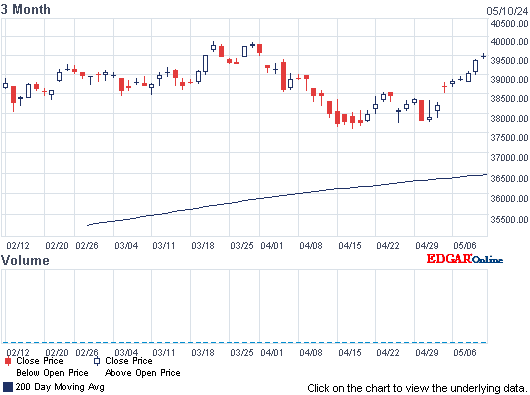Dow rose 21, decliners slightly ahead of advancers & NAZ fell 5. The MLP index dropped 3+ to the 492s & the REIT index slid fractionally lower, but still above 320 near its yearly high. Junk bond funds were mixed & Treasuries retgreated. Oil is back at 77 while gold did little.
AMJ (Alerian MLP Index tracking fund)
Fewer Americans than forecast filed applications for unemployment benefits last week, a sign persistent demand is fueling gains in the labor market. First-time jobless claims dropped 10K to a 3-week low of 278K according to the Labor Dept. The forecast called for 285K. The 4-week moving average, a less-volatile measure of job cuts, reached the lowest level in more than 14 years. Cutbacks in dismissals & increased hiring are sustaining household purchases, which account for 70% of the economy. Wages that have been slow to pick up remain a headwind for bigger spending gains that would make it easier for the expansion to accelerate. The 4-week average declined to 279K, the lowest since Apr 2000, from 281K. The number continuing to receive benefits fell 39K to 2.35M, the fewest since Dec 2000. The unemployment rate among people eligible for benefits held at 1.8%.
First-Time Jobless Claims in U.S. Fell More Than Forecast
Productivity of US workers rose more than projected in Q3, helping to contain labor costs even as employment picks up. The measure of employee output per hour increased at a 2% annualized rate, after a revised 2.9% pace in Q2 that was stronger than previously estimated, according to the Labor Dept. The forecast called for a 1.5% advance. Expenses per worker increased at a 0.3% pace, less than projected. Businesses have been wringing more efficiency from their workforces to control costs as the economic expansion has been slow to gain momentum. At the same time, limited compensation costs signal corp profits have room to grow while inflation is unlikely to become a concern for the Federal Reserve, giving policy makers room to keep interest rates near zero even after ended monthly bond purchases. Unit labor costs, which are adjusted for efficiency gains, were forecast to rise 0.5% in Q3. They dropped at a 0.5% pace in Q2, revised from an initially reported decrease of 0.1%. Adjusted for inflation, hourly earnings increased at a 1.2% rate, after declining at a 0.7 % pace in Q2. Among manufacturers, productivity increased at a 3.2% rate. Worker efficiency climbed 0.9% from the same time in 2013, while labor costs rose 2.4%. The Q3 reading on productivity was close to the 2.2% average over the period from 2000-2012.
Productivity in U.S. Rises More Than Forecast, Curbing Costs
ECB pres Mario Graghi said he’ll be ready to boost stimulus to the economy if needed, as he dismissed claims of acting without the backing of his colleagues. Draghi said he isn’t operating a “kitchen cabinet,” & underlined that all policy makers support additional measures in principle. He said the ECB’s actions might push its balance sheet back toward €3T ($3.72T). In stressing unanimity of purpose, Draghi is seeking to smooth over divisions in his own ranks about the precise way the ECB can aid the economy more, as pessimism about the outlook builds. While the central bank is already expanding its range of asset purchases, it has yet to commit to broad-based bond buying, or quantitative easing. The ECB’s leadership has “has tasked relevant euro system committees with the timely preparation of further measures to be implemented if needed,” Draghi said after the ECB left interest rates unchanged. This commitment “has been signed by the whole Governing Council.” Programs already announced this year, such as a long-term loan initiative & purchases of covered bonds, will “have a sizable impact on our balance sheet, which is expected to move toward the dimensions it had at the beginning of 2012,” said Draghi. “They will thereby futher ease the monetary policy stance more broadly.” “We are quite confident that the impact on our balance sheet will be adequate, significant, sizeable,” Draghi said. “Our balance sheet will keep expanding, while the balance sheet of other central banks will contract. We are on diverging monetary policy paths.”
Draghi Plays Down ECB Rift as Officials Study More Stimulus
Once again, not much going on in the markets. The ECB meeting was unexciting as interest rates were left alone & vague promises were given about doing something if things get very bad. Tomorrow the report on jobs created in Nov will be announced & expectations are for another 200K+ number, good but short of spectacular. There is still a lot of head scratching, trying to figure out what changes the elections will bring to the economy. It looks like the pres is standing firm on about everything he believes in which could lead to more gridlock.
Dow Jones Industrials

AMJ (Alerian MLP Index tracking fund)
| CLZ14.NYM | ...Crude Oil Dec 14 | ...77.63 | (1.3%) |
| GCX14.CMX | ...Gold Nov 14 | ....1,144.40 | (0.1%) |
Fewer Americans than forecast filed applications for unemployment benefits last week, a sign persistent demand is fueling gains in the labor market. First-time jobless claims dropped 10K to a 3-week low of 278K according to the Labor Dept. The forecast called for 285K. The 4-week moving average, a less-volatile measure of job cuts, reached the lowest level in more than 14 years. Cutbacks in dismissals & increased hiring are sustaining household purchases, which account for 70% of the economy. Wages that have been slow to pick up remain a headwind for bigger spending gains that would make it easier for the expansion to accelerate. The 4-week average declined to 279K, the lowest since Apr 2000, from 281K. The number continuing to receive benefits fell 39K to 2.35M, the fewest since Dec 2000. The unemployment rate among people eligible for benefits held at 1.8%.
First-Time Jobless Claims in U.S. Fell More Than Forecast
Productivity of US workers rose more than projected in Q3, helping to contain labor costs even as employment picks up. The measure of employee output per hour increased at a 2% annualized rate, after a revised 2.9% pace in Q2 that was stronger than previously estimated, according to the Labor Dept. The forecast called for a 1.5% advance. Expenses per worker increased at a 0.3% pace, less than projected. Businesses have been wringing more efficiency from their workforces to control costs as the economic expansion has been slow to gain momentum. At the same time, limited compensation costs signal corp profits have room to grow while inflation is unlikely to become a concern for the Federal Reserve, giving policy makers room to keep interest rates near zero even after ended monthly bond purchases. Unit labor costs, which are adjusted for efficiency gains, were forecast to rise 0.5% in Q3. They dropped at a 0.5% pace in Q2, revised from an initially reported decrease of 0.1%. Adjusted for inflation, hourly earnings increased at a 1.2% rate, after declining at a 0.7 % pace in Q2. Among manufacturers, productivity increased at a 3.2% rate. Worker efficiency climbed 0.9% from the same time in 2013, while labor costs rose 2.4%. The Q3 reading on productivity was close to the 2.2% average over the period from 2000-2012.
Productivity in U.S. Rises More Than Forecast, Curbing Costs
ECB pres Mario Graghi said he’ll be ready to boost stimulus to the economy if needed, as he dismissed claims of acting without the backing of his colleagues. Draghi said he isn’t operating a “kitchen cabinet,” & underlined that all policy makers support additional measures in principle. He said the ECB’s actions might push its balance sheet back toward €3T ($3.72T). In stressing unanimity of purpose, Draghi is seeking to smooth over divisions in his own ranks about the precise way the ECB can aid the economy more, as pessimism about the outlook builds. While the central bank is already expanding its range of asset purchases, it has yet to commit to broad-based bond buying, or quantitative easing. The ECB’s leadership has “has tasked relevant euro system committees with the timely preparation of further measures to be implemented if needed,” Draghi said after the ECB left interest rates unchanged. This commitment “has been signed by the whole Governing Council.” Programs already announced this year, such as a long-term loan initiative & purchases of covered bonds, will “have a sizable impact on our balance sheet, which is expected to move toward the dimensions it had at the beginning of 2012,” said Draghi. “They will thereby futher ease the monetary policy stance more broadly.” “We are quite confident that the impact on our balance sheet will be adequate, significant, sizeable,” Draghi said. “Our balance sheet will keep expanding, while the balance sheet of other central banks will contract. We are on diverging monetary policy paths.”
Draghi Plays Down ECB Rift as Officials Study More Stimulus
Once again, not much going on in the markets. The ECB meeting was unexciting as interest rates were left alone & vague promises were given about doing something if things get very bad. Tomorrow the report on jobs created in Nov will be announced & expectations are for another 200K+ number, good but short of spectacular. There is still a lot of head scratching, trying to figure out what changes the elections will bring to the economy. It looks like the pres is standing firm on about everything he believes in which could lead to more gridlock.
Dow Jones Industrials














No comments:
Post a Comment